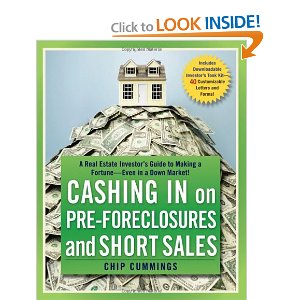Cashing in on Pre-foreclosures and Short Sales – Chip Cummings – Book Review
I still have a lot to learn, but I'm not a complete novice. I just purchased my eighth investment property in October of 2012.
Several of these properties were foreclosure listings. I've found many of these real estate investment books are geared toward complete newbies and don't contain any meat for a intermediate real estate investor.
That wasn't the case with this book!
This was a fantastic book. One strategy that I have never heard of was the idea of buying property "subject to" the existing liens. This was a strategy the author claims to have used hundreds of times. It's a little complex and there is no way I could properly explain it in the body of this post, but trust me when I say it could be the difference between me doing 2 - 3 flips a year and doing 8 - 10.
I'm already investigating the possibilities with my realtor and closing attorney and it looks like this is going to be everything the author promised it would be.
MY NOTES FROM THE BOOK:
1. Court House Foreclosure Auctions
96% of all foreclosed homes that are auctioned at the courthouse steps go back to the lender. This means the lender was unwilling to accept the maximum bid offered at the auction and decided to keep the property and sell it through another method.
2. Security Instruments By State
Link to Fannie Mae Security Instruments by State p.36
3. Avoiding Foreclosure Rescue and Loan Modification Scams
Freddie Mac Information on Avoiding Foreclosure Rescue and Loan Modification Fraud p.58
4. Licensed Service Companies
Author recommends using a licensed servicing company when entering into an installment sales contract. A couple of companies he recommends are:\r\n\r\nNote Servicing Center\r\nReliable Loan Servicing p.59
5. 10 Property Financing Limit
The book makes mention of the four property limit with Freddie Mac and the ten property limit with Fannie Mae. In addition to flips, I\'m also buying duplexes to hold for the long term. I'm closing on my fifth in a couple of weeks and have already been made aware of the ten property limit by my lender.
This doesn\'t mean it\'s illegal to own more than ten properties. It simply means you can't finance more than ten properties with a standard mortgage. Once you get to property eleven, you need to pay cash, secure a commercial loan with a local bank, or some other type of financing. p.63
6. Assumable Mortgages
FHA loans that were placed on properties before December 14, 1989 are fully assumable and do not have any qualifying requirements. The same for VA loans placed on property before March 1, 1988. This means the loan can be transferred to you very easily. p.65\r\n\r\n7.
Taking Title Subject To
Assuming non-assumable loans is possible with a strategy known as buying a property or taking title "subject to" the existing liens.
With an assumable loan, the loan is actually put into your name or at the very least the lender is put on notice. Purchasing a property "subject to" is simply trying to do a simple assumption without telling anyone.
Lenders usually catch on when a loan that is months behind is caught up from a check written off of someone else\'s checking account. The due on sale clause gives the lender the right to accelerate the loan. Unless you are prepared to pay off the loan in full once it is accelerated, avoid this strategy. p.66
8.Violating the Due On Sale Clause
There is nothing illegal about violating the due-on-sale clause. It simply gives the lender the option of calling the note due and payable and triggers the acceleration clause. The author states that in over 25 years of testing this clause, he has never had a lender call the note due.
When the due-on-sale clause is breached, the lender has three options:
Demand payment for the balance of the loan . Foreclose on the loan. Do nothing.
There are two ways to assume a non-assumable loan.
Send a certified letter to the Loss Mitigation Department asking for permission to assume the loan on the borrower's behalf. Include personal financial information and give them permission to run a credit report. Ask for a reply in writing and promise to send a cashier\'s check to bring the loan current.
Option 2 is to simply send a letter to the bank informing them of your intent to assume the loan then begin making payments. The author states he has never had a lender refuse to take his money.
On a VA loan, you can avoid triggering the due-on-sale clause by purchasing the property on a land or installment sales contract. The VA addressed this option in their handbook (H26-94-1) p.67
9. Contacting Real Estate Agents
This book contains a great form letter for contacting and notifying realtors of your intent and putting them on the lookout for foreclosed properties for you. p.85
10. Foreclosure Notices
In chapter 11, the author gives some examples of the type of letters and notices homeowner\'s can expect to receive who are facing foreclosure. He also discusses foreclosure listing services and why they are like buying an old paper. Once the notice hits the paper, everyone knows about it. The key to succeeding in this business is getting the information before it is widely known. p.93
11. Foreclosure Listing Services
The author has made it clear that the best information is information that isn't widely known. Once a foreclosure notice hits the press or one of these foreclosure listing services, it's anyone's game. For that reason, he recommends using this listing services only a supplement and not as a single source of information.
Realty Trac p.107
12. Locating Missing Sellers
Here are a few sites recommended by the author for locating sellers that have abandoned a property.
Any Who p.110
n13. Finding Sellers
There are some good sample classified ads on page 110. This is definitely something worth considering.
14. Six Letter Approach To Persuading Sellers
There are six great sample letters to send to sellers that are facing foreclosure. These letters also include a timeline of the interval they should be mailed. There is some great information here on marketing to, contacting, and meeting with potential clients. p.116 - 122
15. Verifying Property Information
You can verify any insurance claims filed against the property from a Home Seller\'s Disclosure Report form Choice Trust or C.L.U.E. Only the homeowner can order it. p.133
Also, you will need to contact the seller's lender, but you will need permission to do so. You will also need an Estoppel letter. This requires the lender to state the terms of the loan, how much is owed, and what expected penalties will be. This prevents the lender from making a bigger claim once the ball is rolling. Pages 134 - 137 contains some example borrower release forms and estoppel letters.
16. Bankruptcy Information
You can view bankruptcy cases at www.13DataCenter.com. However, I'm not sure what is required to setup an account. I have yet to find a registration button? p.180
17. Negotiating with Lienholders
There are two types of lienholders: Junior and Senior. Senior lienholders are the primary lienholders and are often referred to as first position lienholders. Junior lienholders are represented by second and third mortgages. When a mortgage goes into default, Trustees are required to contact all lienholders. Whenever a senior lienholder initiates foreclosure proceedings, all junior lienholders are listed as defendants. In the event of a foreclosure, the senior lien holder will be paid first, followed by the secondary lienholders. p.178
In order to remove a Federal Tax Lien, the taxpayer will be required to sign and IRS form 8821 which is a power of attorney assignment form and give you the right to obtain tax information and settle or dispute the lien.
You can also contest the validity of a lien in court. The lienholder will be notified and will be given a chance to prove it\'s legitimacy.
Lienholders sometimes disappear. If you are unable to track down a lienholder, you can file a quiet title action and after an appropriate waiting period, the lien can be removed. p.181
It wouldn\'t be unusual to contact junior lienholders and ask them to discount the balance of the lien. Some guidelines and a sample letter are included on pages 181 - 183.
18. Private Mortgage Insurance and Short Sales
I've purchased a short sale property and this is one aspect that I didn't even consider. PMI is an insurance policy that covers the lender in the even the borrower defaults on the loan. Most times, borrowers with less than 20 percent equity are required to purchase PMI on the lenders behalf at the time of the loan.
If PMI is in place, it certainly plays a part in what amount the lender is willing to accept in a short sale situation. The PMI company will have to sign off on
the short sale. Three options exist for the PMI insurer. Advance funds to the borrower to cure the default and keep them in the home. Purchase the loan from the bank and do a loan modification. Approve the short sale and reimburse the lender for any losses up to the covered amount.More and more PMI companies are stepping up the plate and approving short sales or giving the borrowers the cash to stay in the property. p.194
19. Purchase Agreements Don't use purchase agreements prepared by the sellers attorney, generic office supply store contracts, or real estate agent agreements. Hire an attorney to prepare your own purchase agreement. p.203
20. Voluntary Action Agreement This disclosure is for the seller to state that they are agreeing to this sale without any pressure on your part as a buyer. You want their voluntary statement that this is an arms length transaction and you have no power to force the sale and have not done so. pg 212s



Leave a Reply